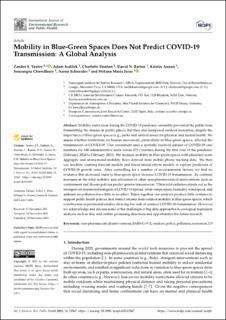| dc.description.abstract | Mobility restrictions during the COVID-19 pandemic ostensibly prevented the public from transmitting the disease in public places, but they also hampered outdoor recreation, despite the importance of blue-green spaces (e.g., parks and natural areas) for physical and mental health. We assess whether restrictions on human movement, particularly in blue-green spaces, affected the transmission of COVID-19. Our assessment uses a spatially resolved dataset of COVID-19 case numbers for 848 administrative units across 153 countries during the first year of the pandemic (February 2020 to February 2021). We measure mobility in blue-green spaces with planetary-scale aggregate and anonymized mobility flows derived from mobile phone tracking data. We then use machine learning forecast models and linear mixed-effects models to explore predictors of COVID-19 growth rates. After controlling for a number of environmental factors, we find no evidence that increased visits to blue-green space increase COVID-19 transmission. By contrast, increases in the total mobility and relaxation of other non-pharmaceutical interventions such as containment and closure policies predict greater transmission. Ultraviolet radiation stands out as the strongest environmental mitigant of COVID-19 spread, while temperature, humidity, wind speed, and ambient air pollution have little to no effect. Taken together, our analyses produce little evidence to support public health policies that restrict citizens from outdoor mobility in blue-green spaces, which corroborates experimental studies showing low risk of outdoor COVID-19 transmission. However, we acknowledge and discuss some of the challenges of big data approaches to ecological regression analyses such as this, and outline promising directions and opportunities for future research | en_US |

